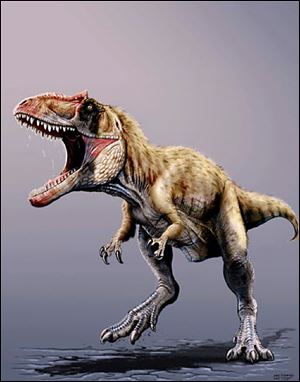
FOSSIL FOUND IN UTAH
Scientists find new species of dinosaur
Field Museum officials detail 2008 discovery
11/24/2013
An artist’s rendering shows Siats meekorum, a precursor to T. rex as the dominant predator in North America.
CHICAGO — Field Museum scientists have discovered a new “top predator” dinosaur in North America, a significant precursor to Tyrannosaurus rex and an important part of an emerging fossil record for the continent.
The 4-ton, 30-foot animal was discovered in a region of 100-million-year-old rock in Utah during a museum expedition led by Peter Makovicky, curator of dinosaurs, and Lindsay Zanno, then a postdoctoral fellow at the museum.
Siats meekerorum — named by the scientists after a man-eating monster of legend from the region’s Ute Indian people and the Meekers, a museum donor family from Evanston, Ill. — helps flesh out what has been a skeletal picture of North American wildlife in the tens of millions of years before T. rex was the dominant predator.
Though Siats is the third-largest carnivore found on the continent, this fossil is no Sue, the largely intact T. rex skeleton that presides over the Field’s central hall.
It takes imagination to turn the smattering of bones that rested last week on a striped tablecloth in the museum’s back office into a predatory behemoth.
But mostly it takes science, the kind of knowledge that can extrapolate from a hipbone’s telltale notch and distinctive openings in vertebrae to determine that this was a member of the allosauroids’ megaraptor subgroup.
In 2008, Ms. Zanno saw the first of the bones on a hillside in Utah’s Cedar Mountain Formation, days before the group’s relatively unfruitful expedition was to end and as “morale was low,” said Ms. Zanno, now director of paleontology at the North Carolina Museum of Natural Sciences.
Friday’s publication in Nature Communications of Ms. Zanno’s and Mr. Makovicky’s paper, “Neovenatorid theropods are apex predators in the Late Cretaceous of North America,” marks the official unveiling of the new species.
“It’s more than just a new dinosaur,” Mr. Makovicky said. “It’s the first evidence we have of a whole new group of dinosaurs in North America.”
The S. meekerorum announcement follows one earlier this month that Lythronax argestes, a smaller T. rex ancestor from 80 million years ago, had been discovered in southern Utah, proving that such predators had been around some 10 million years earlier than previously known.
Because of its size and the history of top predators elsewhere, Ms. Zanno and Mr. Makovicky theorize, Siats was atop a food chain that included what their paper calls “small-bodied tyrannosauroids,” T. rex’s ancestors, which hadn’t evolved to the size they would reach before dinosaurs went extinct 65 million years ago.
Siats, though, isn’t related to the tyrannosauroid family but rather to the allosauroids. Its best-known relative might be the Giganotosaurus, found in South America.